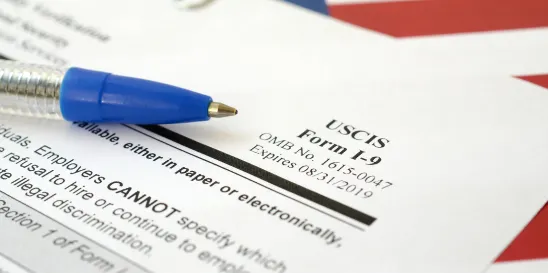The Department of Homeland Security (DHS) and Department of Justice (DOJ) recently issued a fact sheet to guide employers on electronically completing, modifying, or retaining Form I-9. The joint guidance applies to employers using private sector commercial or proprietary I-9 software programs to complete Form I-9 or participate in E-Verify.
Requirements for Employers Using Electronic Form I-9 Software Programs
DHS permits completing Form I-9 electronically provided that the I-9 software complies with I-9 and E-Verify requirements. The DHS/DOJ fact sheet confirms that employers, rather than the software vendor, are responsible for ensuring compliance with these requirements. It provides the following key requirements and states that an I-9 software must:
- Provide employees with access to the current acceptable version of Form I-9, I-9 instructions, and list of acceptable documents.
- Allow employees to leave optional fields blank and accommodate employees with only one name.
- Meet integrity, accuracy, security, and reliability requirements designed to prevent and detect unauthorized or accidental creation, alteration, or deletion of stored I-9s.
- Comply with standards for electronic I-9 signatures.
- Comply with general requirements applicable to I-9 documentation, retention, and audit trail requirements.
- Ensure the electronic generation or storage of Form I-9 is inspected and monitored periodically.
- Ensure the I-9 forms and all information fields on electronically retained I-9s are fully and readily accessible in the event of a government audit.
Specifically related to modifying and retaining Forms I-9 electronically, the fact sheet states that I-9 software must provide employees, employers, and preparers/ translators the option to make and record corrections to a previously completed I-9 form. Further, the software must uniquely identify each person who accesses, corrects, or changes an I-9 form. Modifications to stored I-9 forms must be properly annotated to include the date of access, the identity of the person making the change, and the nature of the change. Commercial or proprietary I-9 software may lack the functionality to comply with these guidelines regarding providing an audit trail and permitting corrections to completed I-9 records, so these are specific considerations employers should be aware of when assessing potential I-9 software for compliance.
Requirements for Employers Using Electronic Form I-9 Software Programs to Create E-Verify Cases
The DHS/DOJ fact sheet notes that employers who participate in E-Verify and access E-Verify through a software must:
- Confirm that the software’s functionality allows employers to follow the requirements detailed in the E-Verify Memorandum of Understanding and DHS’s E-Verify guidance.
- Refrain from creating new E-Verify cases due to corrections made to the previously completed I-9 if the employee received a prior “employment authorized” result. Depending on functionality, commercial or proprietary I-9 software may require completing a new I-9 instead of allowing a correction to the previously completed form.
- Be able to delay creating E-Verify cases as instructed by E-Verify rules. For example, E-Verify instructs employers to postpone creating E-Verify cases for employees who have not yet received their Social Security numbers and for employees who show certain acceptable receipts for the Form I-9. The software’s functionality should permit employers to delay creating the E-Verify case in these scenarios.
Training for Employer Personnel Administering I-9 Software on Behalf of the Employer
The DHS/DOJ fact sheet also reminds employers to properly train personnel completing electronic Forms I-9 on the employer’s behalf. Key points include the following:
- Employer personnel should be familiar with the employer’s procedures to complete Form I-9 or create an E-Verify case outside of the Form I-9 software program if, for example, the person completing the I-9 cannot use the I-9 software program or there is a software outage.
- Employers should not pre-populate fields on electronic I-9 forms with employee information. An I-9 software may be part of the employer’s other HR-related systems and the system may initiate the I-9 verification process through impermissibility pre-populating the employee’s information on the electronic I-9.
- The employer must not use auto-correct, use predictive text, or post-date an I-9 when completing an I-9 with an I-9 software.
- The employer should not complete the I-9 on an employee’s behalf and must not change or update the employee’s citizenship or immigration status attestation. For corrections to Section 1, the process is the same as when completing a paper I-9 and changes or corrections to Section 1 must be made by the employee. The I-9 software must have the functionality to allow the employee to make corrections to a previously completed I-9 form.
- The employer must not remove or add fields to Form I-9. An I-9 software that adds additional questions seeking information that is not requested by the I-9 form may violate this guidance.
- Employers must permit preparers or translators to assist an employee in completing an electronic I-9.
- Employers must permit employees to present any valid and acceptable documentation to establish identity and employment authorization, including acceptable receipts, and should not suggest specific documents for this purpose. Thus, an I-9 software should not notify the employer to, for example, request documentation to reverify an employee’s identity document or reverify a permanent resident card.
- The fact sheet reminds employers to not impose unnecessary obstacles that make it more challenging for employees to start work or get paid, such as by requiring a Social Security number to onboard or by not paying an employee who can complete the Form I-9 but is still waiting for a Social Security number.
Given the significant penalties for non-compliance, employers should exercise thorough due diligence when evaluating I-9 software, considering compliance with DHS regulations alongside factors like cost, functionality, and interoperability with its other systems. Although government guidance has been minimal, the fact sheet provides some insight into the government’s stance on regulatory requirements for electronic I-9s and may be helpful to employers when selecting an I-9 software.



 />i
/>i

